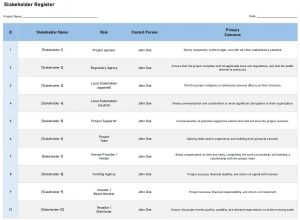
Many project managers believe that delivering a project on time, within budget, and meeting all specifications guarantees success. While these are critical, they don’t tell the whole story.
Every project is shaped by its stakeholders—individuals or organizations whose interests intersect with the project, whether supportive or opposed, aware or unaware. This includes the project team, sponsors, and beyond. The true measure of a project’s success lies not in the project manager’s assessment but in the stakeholders’ perception.
And therein lies the essence of project management. The real hidden game-changer is that the project’s stakeholders actually determine whether or not the project is a success, not the project manager. Thus, if the project finishes on time and budget, and within all of the specifications, it will probably be a success. But only if the stakeholders decide that it will be.
Naturally then, stakeholder management is a major concern for project managers. And the first step in Stakeholder Management is the identification of all the stakeholders via a document called the Stakeholder Register.
What is a Stakeholder Register?
In project management, a stakeholder register is a document that lists a project’s stakeholders as well as information about their involvement in the project.
In the Project Management Body of Knowledge (PMBOK), a stakeholder register is an artifact within the Stakeholder Performance Domain.
As a minimum, a stakeholder register contains a list of the project’s stakeholders, for example,
| Stakeholder ID | Stakeholder Name |
|---|---|
| 1 | Parent Organization |
| 2 | Project Team |
| 3 | Investor |
| 4 | Supplier |
| 5 | Regulatory agency |
| 6 | Adjacent landowner |
However, a truly effective stakeholder register contains a few more items.
Parts of a Stakeholder Register
There are three main parts to a good stakeholder register:
- Stakeholder Identification
The name of the stakeholder group, organizational hierarchy, location and contact details. Most stakeholders are easy to find. But it’s precisely those ones that you don’t talk to very often that are most likely to trip up your project. - Assessment information
The stakeholder’s role in the project, and the major requirements or expectations that they have. Where the stakeholder is likely to exert their influence, how they will exert that influence, and the phase of the project life cycle in which the influence is likely to be exerted. - Stakeholder classification
Stakeholders can be either internal or external. Their impact can be classified as upward, downward, outward, or sideways. They can also be classified based on their influence and impact on the project.
Stakeholder Register – Template
 Our high quality Stakeholder Register template is free to download and use as you see fit on your project. It comes pre-filled with 10 typical project stakeholders and their needs.
Our high quality Stakeholder Register template is free to download and use as you see fit on your project. It comes pre-filled with 10 typical project stakeholders and their needs.
The Stakeholder Register is part of a more comprehensive Stakeholder Engagement Plan which includes a stakeholder analysis and communication plans.
Stakeholder Identification
Generally speaking, project stakeholders fall into three categories:
- Organizational stakeholders
These are the stakeholders from within the organization. They include senior management, technical management, and line managers, who are generally interested in a successful project and a product that is successful in the marketplace. They also include the project team itself, which is interested in job security, fair wages (or maximum wages) and career advancement. Other internal stakeholders like unions, product groups, and so forth have a minor or passive role. - Product and market based stakeholders
This category contains the stakeholders that have a “stake” in the product, but not the organization. It includes customers who are interested in purchasing a product that improves their lives for a fair price. It also includes suppliers who provide tools, equipment, and services to the project. They generally wish to be treated fairly and leave the project with a good reference for future business. It also includes governments who have a regulatory interest in the product, who wish to protect the public from adverse consequences of using the product. And finally, the general public, who are not stakeholders until they experience negative affects from the project’s activities. - Funding based stakeholders
The third category of stakeholder is the person or organization that supports the project financially. Investors, creditors, and banks who have funded the project are interested in making a return on their investment in a reasonable time frame.
Each of these stakeholders should be recorded, complete with contact names, job descriptions, location on the organizational structure, authority level, and role in the project. In short, effective stakeholder management dictates that you must know who has the ability to influence your project so you can obtain rapid decisions when problems arise.
Stakeholder Assessment
 Most of the time, stakeholders have one obvious “stake” in the project, for example a regulatory agency that requires an environmental assessment prior to issuing permits. But it is not always that simple. Often they have lesser requirements which initially take a back seat but come to the forefront only when they are not met.
Most of the time, stakeholders have one obvious “stake” in the project, for example a regulatory agency that requires an environmental assessment prior to issuing permits. But it is not always that simple. Often they have lesser requirements which initially take a back seat but come to the forefront only when they are not met.
Each stakeholder should be assessed as to what their requirements are.
Furthermore, each stakeholder has expectations as to how the project will proceed, and their actions are governed by those expectations which might not be visible until they are not being met. For example, the adjacent landowner might be concerned about the noise level of a project, but they might not say anything if they don’t anticipate an unacceptable amount of noise. Then, when an unacceptable level of noise is produced, it becomes a project issue that was not addressed. Hence, the stakeholder register should analyze each stakeholder’s expectations.
In addition, stakeholders have varying levels of influence. From providing feedback up to completely halting a project, every stakeholder falls somewhere on the continuum, and the project manager should assess where on the continuum each stakeholder sits. Obviously, stakeholders that can halt the project must get a proportionately higher attention from the project manager.
Stakeholders also enter the project at different phases of the project life cycle. If a stakeholder is not concerned until later on in the project, the project management team does not have to be concerned with them in the short term.
Stakeholder Classification
Stakeholders can be classified in several different ways. One of those is Internal/External, which can be used to determine contractual and procurement requirements.
- Internal are stakeholders that are within the parent organization, for example the project team, technical managers, or executives.
- External stakeholders are outside the parent organization, for example suppliers, regulatory agencies, and adjacent landowners.
 Another classification method is called Impact/Influence, which is used to ascertain potential adverse project impacts. In this classification:
Another classification method is called Impact/Influence, which is used to ascertain potential adverse project impacts. In this classification:
- Impact is the magnitude of the potential disruption to the project.
- Influence is the ability to motivate others to disrupt the project.
- Those with influence must be kept satisfied.
- Those with impact must be kept informed.
- Those with both impact and influence must be managed closely.
Another classification is called upward/downward/outward/sideward, which is a good way to distinguish between the types of communication required by each stakeholder. In this classification model, each stakeholder is classified in one of four ways:
- Upward is related to the parent organization: Executives, investors, and project sponsors. These stakeholders have business and financial interests in the project.
- Downward are stakeholders who are underneath the project hierarchy: Suppliers, contractors, service providers, and so forth. The project team itself also counts as downward.
- Outward are stakeholders who have a “stake” in the project, such as government regulators, adjacent landowners, end users, customers, and even the general public.
- Sideways are stakeholders who are in competition with the project for scarce resources, such as other project managers and organizational departments.
Stakeholder Analysis
Because the purpose of the stakeholder register is to identify and classify stakeholders, a comprehensive stakeholder analysis is the next step. In the PMBOK, stakeholder analysis is a method of the Stakeholder Performance Domain.
In short, once the stakeholder register has been completed the stakeholder analysis provides a more comprehensive summary of the stakeholder’s needs and wants.
As you would expect, stakeholders have different values and interests. Because of this, project managers must not only understand the stakeholder’s needs and objectives but also possess strong communication, negotation, and conflict resolution skills to ensure the stakeholder is satisfied with the end result of the project.
Stakeholders can be motivated by any number of factors, including:
- Financial interests
- Moral and ethical values
- Religious beliefs
- Political opinions
- Business interests
- Demographics
- Environmental stewardship
- Value of ownership
- Communication preferences
The stakeholder analysis builds on the stakeholder register, provides the analysis of what the stakeholder’s requirements are, and how they might change throughout the project.











Leave a Reply